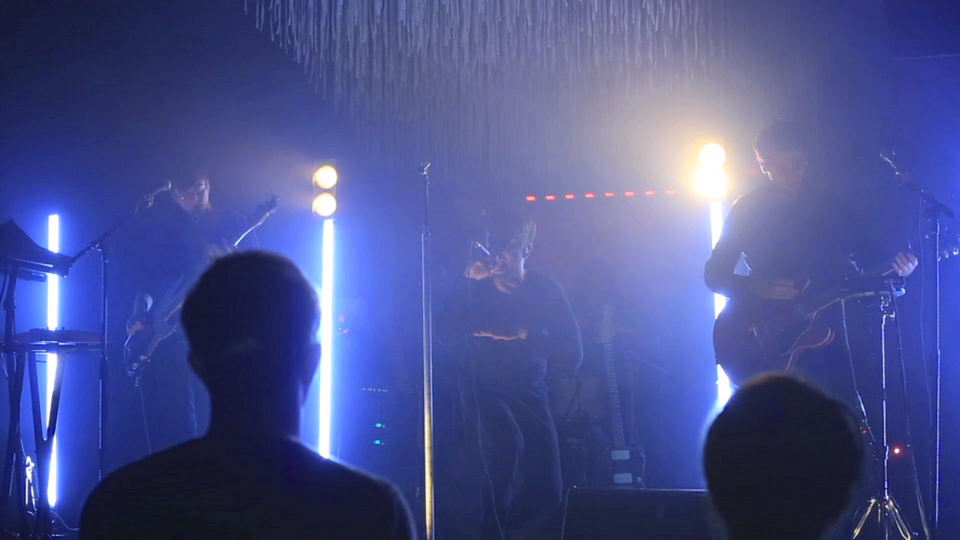the concept
Due to the nature of Lustinger’s music, there is inherently a large number of electronic instruments and the sync between them is very important. The entire system was designed for ease of setup and consistency. Even though the band is playing small venues, we carry our own Behringer X32 mixing console so that we can maintain consistency between venues and reduce the impact that we have on the venue.
The system is contained in one 12 space rack and all cabling is fed into this rack via three bundles of cabling. The cabling was designed to drop in key locations on the stage for easy patching so that the area around the rack is not crowded.
The entire system can be setup in 10 minutes and cleared even faster.
the playback system
I decided on Qlab for playback since it handles audio tracks and MIDI tracks simultaneously. Each song is represented by a group cue and each group cue has multiple audio and MIDI tracks in it. There is a click track and a backing track audio file as well as a lighting MIDI file and a Mainstage trigger MIDI file in each group cue. Each group cue also has a global STOP cue to stop any other cues that were playing for fast switching between songs. I added an auto-follow to the last cue in each group cue so that the set will run automatically without the drummer having to trigger each song. This playback system drives the entire show and all its effects.
mainstage
Since Joseph writes all his songs with Apple’s Logic, it made sense to use Mainstage for the synth, electronic drum and special vocal effects. It was very simple to copy the channels from the demo’s Logic session into the Mainstage concert. Qlab’s MIDI output switches the Mainstage patch changes automatically during each song. Automatic patch changes allow the system to be autonomous.
Although Mainstage’s interface is not the most intuitive, it allows for reliable effects and synth patches. We are even able to control parameters during the performance to add a more live feel to the performances.
monitoring
In a typical small venue show, the use of stage monitors makes the performer’s job and the sound person’s job very difficult. I decided to use an Aviom system to alleviate this problem. Each band member has an Aviom A16-R that they use to mix their own wired in-ear mix. This system works fairly well, although I have learned that the separate mixes have isolated the band members from each other in such a way that they don’t always hear their performances in the same way thus making for a less cohesive overall sound. This is something we will work on in the future by setting stage volumes without the in-ears. The band members’ experience onstage contributes to the audience’s energy. When the band is not having a good time due to tech issues, it translates to the audience.
vocal effects
Most of the special vocal effects used in the songs originate from Mainstage. These were copied from the original Logic sessions, then modified for live use. They include distortions, delays, chorus and reverbs. Since they are triggered with the Qlab MIDI file, the patch changes happen automatically as the song is played. The output is patched to the console on its own channel and allows for easy blending with the dry vocal channel. Additional vocal effects come from the Kaoss Pad that Niko plays. This signal chain is explained further in the signal flow section. The effects provide a distinct sound that is unique in the local music scene.
signal flow
To accommodate this complex signal flow, I provided an 8 channel mic splitter. One side of the mic splitter goes into the Behringer S16 and the other goes into a Behringer ADA8000 8 channel preamp. The Behringer preamp output feeds into the Aviom A-16i input unit for the two guitars and the bass.
The vocal mics have a different flow. The output of the ADA8000 for Joseph’s vocal channel is “y’d” into the Mainstage input and to the Kaoss Pad input. The vocal mics feed into the S16 and each has its own mix output that feeds the Aviom system which allows us to EQ the vocal mics into their in ears. The drum mics feed directly into the S16 and a mix output feeds the “drums” channel of the Aviom system. A final output mix from the S16 provides a reverb return on the vocals to the Aviom system.
The S16 MIDI input allows for scene changes automatically which keeps the performances consitent. This MIDI feed is fed from the Qlab file.
